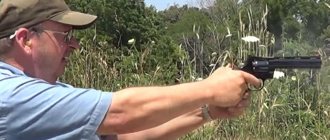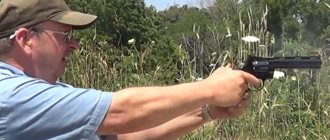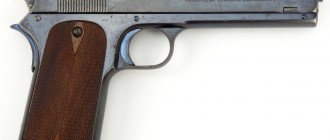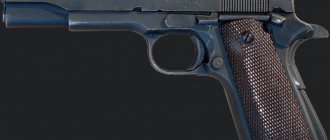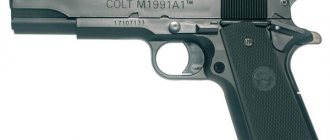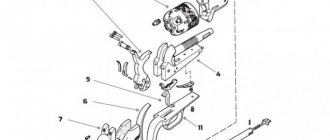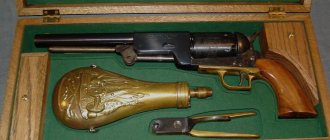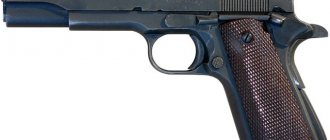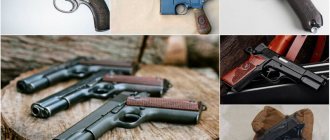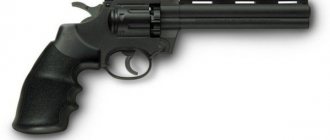Revolver
| Colt Walker | |
| Colt Walker Revolver No. 1017. Metropolitan Museum of Art Collection of Arms and Armor, accession number 58.171.1. | |
| Type | Revolver |
| Place of origin | United States |
| Service history | |
| In service | 1847–1864 Then turned into subsequent projects |
| Used | State of Texas Confederate States of America USA |
| Wars | Mexican-American War American Civil War |
| Production history | |
| Designer | Samuel Colt, Captain Samuel Walker |
| Developed | 1847 |
| Manufacturer | Eli Whitney Jr. in Whitneyville, CT for Saml. Colt, New York |
| Produced | 1847 |
| No built | 1,100 |
| Options | Colt Whitneyville Hartford Dragoon revolver, quantity about 240 |
| Characteristics | |
| Weight | 4.5 lb (2.0 kg) |
| Length | 15.5 inches (390 mm) |
| Caliber | .44 ball, .454 in (11.5 mm) revolver dia. |
| Action | single action |
| starting speed | 1000 to 1350 fps (300–410 m/s) |
| Effective firing range | 100 yards (91 m) |
| Feeding system | six cylinder cylinder |
| Attractions | paddle front sight, percussion rear sight with notch |
Colt Walker
, sometimes known as
a Walker Colt
, is a single-action revolver with a rotating cylinder holding six charges of black powder per six bullets (usually .44 caliber lead balls). It was developed in 1846 as a collaboration between Captain Samuel Hamilton Walker and American firearms inventor Samuel Colt.
History[edit]
Samuel Hamilton Walker (1817–1847)
The 1847 Colt Walker was the most powerful handgun available until 1935, when Smith and Wesson's Model 27, the very first .357 magnum, debuted. The Colt Walker was created in the mid-1840s as a collaboration between Texas Ranger captain Samuel Hamilton Walker (1817–1847) and American firearms inventor Samuel Colt (1814–1862), based on the earlier Colt Paterson design. Walker needed a pistol that was extremely powerful at close range. [1]
Samuel Walker carried two of his namesake revolvers during the Mexican–American War. [2] He was killed in action the same year his famous pistol was invented, in 1847, shortly after he received them. Only 1,100 of these guns were originally produced, 1,000 under military contract and another 100 for the civilian market, making original Colt Walker revolvers extremely rare and expensive to acquire. On October 9, 2008, one example, donated by a Mexican War veteran, was sold at auction for US$920,000. [3]As reported in US magazine 1st Freedom in July 2022, the Colt Walker Model 1847 pistol is the only known surviving example with the original frame, sold by Rock Island Auction for a record price of $1.84 million. This makes it the most expensive single firearm ever sold at auction.
The Republic of Texas was a major purchaser of the early Paterson Holster Pistol (Model No. 5), a .36 caliber five-shot revolver, and Samuel Walker became familiar with it during his service as a Texas Ranger. In 1847, Walker served in the Mexican-American War as a captain in the United States Mounted Fusiliers. He approached Colt and asked for a large revolver to replace the Model 1842 single-shot percussion pistols in use at the time. The desired .44-.45 caliber revolver will be carried in saddle holsters. The Colt Walker was used during the Mexican-American War and on the Texas border. [1]
Medical officer John "Rip" Ford took a special interest in the Walkers when they arrived in Veracruz. He received two copies for himself and is the main source of information about their work during and after the war. His observation that the revolver could shoot as far and hit with equal or greater force than the .54-caliber Mississippi rifle appears to have been based on a single observation of a Mexican soldier being hit at more than a hundred yards. The Walker, unlike most subsequent combat pistols and revolvers, was a practical weapon at a range of about 100 yards. [1]
bobot 03/31/2016 03/31/2016 Category People, TechnologyTags America, military, wars, history, cowboys, Colt, weapons, hunters, pistols, police, revolvers, rangers, Remington, guns, soldiers, Texas, sheriffs Comment.
Colt Paterson
Colt's idea of creating a revolver was prompted by observations of a rotating mechanism on the ship Corvo, on which he traveled from Boston to Calcutta. On board the Corvo, he made a model out of wood; upon returning to the United States, Colt applied to the patent office and issued patent No. 1304 dated August 29 (according to other sources, February 25), 1836, describing the basic principle of operation of a weapon with a rotating drum.
In late 1836, Colt's Patent Firearms Manufacturing Company in Paterson, New Jersey began production of Colt's five-shot .28-caliber cap revolvers, sold under the name Colt Paterson. In total, until 1842, 1,450 revolving rifles and carbines, 462 revolving shotguns and 2,350 revolvers were produced. Naturally, all weapons were percussion caps. The first samples were characterized by low reliability, regular breakdowns and a very imperfect design, not to mention the extremely unsafe and inconvenient reloading process. Not surprisingly, the US government showed little interest in the new weapon. The Army purchased only a few revolver carbines for testing. The largest customer for Colt's company was the Republic of Texas, which bought 180 revolving shotguns and rifles for the Rangers, and about the same number of revolvers for the Texas Navy. A number of revolvers (more powerful caliber - .36) were ordered privately by the Texas Rangers themselves with their own money. Low demand in 1842 led to the bankruptcy of the factory.
Colt Paterson made 1836-1838 (still without loading rod)
Thus, the most popular Colt Paterson revolver model produced in Paterson was the No. 5 Holster, also known as the Texas Paterson, a .36 caliber revolver. About 1,000 units were produced. Half of them occurred in the period from 1842 to 1847, after bankruptcy. Their production was established by Colt's creditor and former partner John Ehlers.
Colt Paterson 1836-1838 with the trigger retracted
One of the most significant conflicts involving the use of Colt Paterson revolvers was the Battle of Bander Pass between the Mexican Army and Texas Rangers, among whom was US Army Captain Samuel Walker. Later, during the Mexican-American War, Walker met Colt and together with him modified the Colt Paterson revolver, called the Colt Walker. There was good demand for it, since the Colt Walker was much more reliable and convenient than its predecessor. Thanks to this, Colt returned to developing weapons in 1847.
Texas Rangers
From a technical point of view, the Colt Paterson is a five-shot open-frame revolver. Single action trigger mechanism (English Single Action, SA) with a trigger folding inside the body. Each time you fire, you have to cock the hammer. The revolver is loaded from the muzzle of the chambers - with gunpowder and a bullet (round or conical) or with a ready-made cartridge in a paper sleeve containing a bullet and gunpowder.
.44 caliber paper cartridges and loading tool
Capsules (still produced today - for lovers of such weapons)
Then a primer is placed on the brand tube in the breech of the drum - a miniature cup made of soft metal (usually brass) with a small charge of shock-sensitive fulminate of mercury. On impact, the charge explodes and creates a jet of flame, which, through a fire tube, ignites the powder charge in the chamber. Everything that has been said about the principles of operation of such weapons applies to all other capsule revolvers.
Sights consist of a front sight and a rear sight on the trigger. Loading early models of Colt Paterson revolvers, produced before 1839, was carried out only by partially disassembling it and removing the drum, using a special tool - essentially a small press for pressing bullets into the chambers of the drum.
This process was long and inconvenient, especially in the field. Not only was reloading the Colt Paterson unsafe, but carrying it was also unsafe, as there were no manual safeties. To speed up reloading, gunfighters usually carried several pre-loaded drums with them and simply changed them as needed. In later models, from 1839, the design featured a built-in pressing lever-ramrod and a special hole in the front of the frame for it. This mechanism made it possible to significantly speed up and simplify reloading - now it was possible to equip the drum without removing it from the revolver. This improvement made it possible to get rid of the additional tool, and from that time on the ramrod lever became an integral element of the design of almost all Colt capsule revolvers.
See also: Boris Nemtsov and “shy provocateurs” (photo)
Colt Paterson made 1842-1847 with a shortened barrel and a ramrod lever for loading
Some performance characteristics of Colt Paterson .36 caliber with a barrel length of 7.5 inches (it should be borne in mind that even for the same model of a capsule weapon they may differ slightly): - muzzle velocity, m/s - 270; — sighting range, m — 60; — weight, kg — 1.2; — length, mm — 350.
So, the first Colt Paterson revolvers were actively used by the Rangers and the Navy of the Republic of Texas, and were used very limitedly by the US Army. Colt Paterson was used in clashes between the Republic of Texas and Mexico, in the Mexican-American War, and in the US war with the Seminole and Comanche tribes.
Such revolvers are very highly valued today. Colt Paterson in original box with all accessories sold at auction in 2011 for $977,500
Colt Walker
The Colt Walker was developed in 1846 by Samuel Colt and Texas Ranger Captain Samuel Hamilton Walker. According to the widespread version, Walker suggested that Colt develop a powerful .44 caliber army revolver instead of the relatively weak and not very reliable .36 caliber Colt Paterson revolvers then in service. In 1847, Colt's newly formed Colt's Manufacturing Company in Hartford, Connecticut (where it remains to this day) produced the first batch of 1,100 Colt Walker revolvers, which also became the last. That same year, Samuel Walker was killed in Texas during the Mexican-American War.
The Colt Walker is a six-shot, open-frame, capsule-operated revolver with an added trigger guard. The Colt Walker is Colt's largest black powder revolver, weighing 2.5 kilograms. From this moment on, all “non-pocket” models of Colt capsule revolvers became six-shooters.
Some performance characteristics of the Colt Walker .44 caliber: - muzzle velocity, m/s - 300-370; — sighting range, m — 90-100; — weight, kg — 2.5; — length, mm — 394.
The Colt Walker was used by both sides in the North-South War.
Colt Walker
Colt Dragoon Model 1848
The Colt Model 1848 Precision Army revolver was designed by Samuel Colt in 1848 for the US government to equip the US Army's Mounted Rifles, better known in the US as dragoons. Hence its name, under which the revolver went down in history - Colt Dragoon Model 1848. In this model, a number of shortcomings of the previous Colt Walker model were eliminated - the Colt Dragoon had less weight and a ramrod lock was added.
Colt Dragoon Model 1848
There were three releases of the Colt Dragoon model, differing from each other by minor improvements in the firing mechanism: - first release: from 1848 to 1850, about 7,000 were produced; - second issue: from 1850 to 1851, about 2,550 were issued; - third edition: from 1851 to 1860, about 10,000 Colt Dragoon revolvers were produced, of which the US government purchased more than 8,000 units.
Thus, the Colt Dragoon was produced for 12 years. The Colt company produced about 20,000 of these revolvers. The Colt Dragoon turned out to be a very successful revolver.
Holster and belt for Colt Dragoon Model 1848
Separately, it is worth noting the production since 1848 of its pocket version, the Colt Pocket Model 1848 in .31 caliber, better known as the Baby Dragoon, especially popular with civilians.
Some performance characteristics of the Colt Dragoon Model 1848 caliber .44, with a barrel length of 8 inches: - muzzle velocity, m/s - 330; — sighting range, m — 70-75; — weight, kg — 1.9; — length, mm — 375. Colt Dragoon Model 1848 was used by the US Army and the Confederate Army in the war of the North and South. A significant portion was sold to civilians.
Colt Pocket Model 1848 Baby Dragoon
Colt Navy 1851
The Colt Revolving Belt Pistol of Naval Caliber (.36 caliber), better known as the Colt Navy 1851, was developed by Colt specifically to equip US Navy officers. Colt Navy turned out to be such a successful model that its production continued until 1873 (from 1861 - Colt Navy Model 1861), when armies around the world switched en masse to a unitary cartridge. The Colt Navy was in production for a record 18 years in various models, with approximately 250,000 of them produced in the United States. A further 22,000 units were manufactured in the UK at the London Armory factory. The Colt Navy is considered one of the most advanced and beautiful capsule revolvers in history.
See also: Was the stand on the Ugra the overthrow of the “Horde yoke”?
Colt Navy 1851
The trigger mechanism has been improved: a special pin is made in the breech of the drum between the chambers, thanks to which, if the drum is not turned enough, accidental firing of the trigger does not cause ignition of the capsules. The Colt Navy has an octagonal barrel.
Colt Navy 1851 revolvers were in service not only with the US Army, where their main competitor was the Remington M1858 revolver, but also with army officers of the Russian Empire (which ordered a large batch from Colt), Austria-Hungary, Prussia and other countries.
Some performance characteristics of the Colt Navy 1851 caliber .36: - muzzle velocity, m/s - 230; — sighting range, m — 70-75; — weight, kg — 1.2-1.3; — length, mm — 330.
Colt Navy was actively used by both sides in the war between the North and South. It became the first capsule revolver to be massively converted to a unitary cartridge.
Winchester .44 Rimfire black powder rimfire cartridges
The differences from the capsule Colt Navy are clearly visible: a new drum with a door in the rear for loading, the ramrod lever has been removed and instead a spring-loaded extractor has been installed to remove spent cartridges, the depth of the recess at the rear of the drum has been increased for ease of loading with cartridges.
Colt Navy Model 1861 conversion
Remington M1858
The Remington M1858 cap revolver, also known as the Remington New Model, was developed by the American company Eliphalet Remington & Sons and was produced in .36 and .44 calibers. Due to the fact that Colt was the patent holder, Remington was forced to pay him a royalty on each revolver produced, so the price of Remington revolvers was significantly higher than similar Colt revolvers. The Remington M1858 revolver was produced until 1875.
Remington M1858
Over 17 years, approximately 132,000 Remington M1858 revolvers were produced in .44 caliber (military model with an 8-inch barrel) and .36 caliber (naval model with a 7.375-inch barrel). There were three large releases in total, which were almost identical - minor differences were in the appearance of the trigger, the design of the under-barrel lever and the drum.
From a technical point of view, the Remington M1858 is a six-shot cap revolver with a solid frame, the loading of which is carried out by placing ready-made cartridges in a paper case or black powder bullets into the chambers of the drum on the muzzle side, after which the primers were placed in the breech of the drum.
Single action trigger mechanism (English: Single Action, SA), no manual safeties.
Some performance characteristics of the Remington M1858 .44 caliber, with an 8-inch barrel: - muzzle velocity, m/s - about 350; — sighting range, m — 70-75; — weight, kg — 1.270; — length, mm — 337.
Remington M1858 revolvers were in service with the army of the United States, the British and Russian empires, Japan, Mexico, and others.
A Northern Army cavalry soldier with three Remington M1858s
The Remington M1858 was actively redesigned for a unitary cartridge. Since 1868, the company itself began producing a conversion version of the Remington M1858 revolver chambered for the .46 rimfire black powder cartridge.
Remington M1858 conversion
Colt Army Model 1860
The Colt Army Model 1860 revolver was developed in 1860 and became one of the most common revolvers during the American Civil War. Produced for 13 years. In total, about 200,000 Colt Army Model 1860 revolvers were produced before 1873, and about 130,000 of them were made for the US government.
It had a modification with longitudinal grooves on the cylinder and less weight - the Texas Model, so named because most of these revolvers were purchased by Texas Rangers after the Civil War.
The Colt Army Model 1860 revolver, along with the Colt Navy 1851 and Remington M1858, became one of the most beloved revolvers of its era. It was actively purchased not only by the military, but also by civilians. Moreover, revolvers were relatively inexpensive back then. For example, a Colt Army Model 1860 cost $20 (for comparison, the price of an ounce of gold on the New York Exchange in 1862 was $20.67).
See also: 5 princesses who were unhappy in their marriages
Colt Army Model 1860
Some performance characteristics of the Colt Army Model 1860 caliber .44: - muzzle velocity, m/s - 270-305; — sighting range, m — 70-90; — weight, kg — 1.2-1.3; — length, mm — 355.
Colt Army Model 1860 revolvers were used by the US Army and the Confederates, and after the Civil War by the Texas Rangers. They took part in the US wars with the Indians: the Colorado War, the Dakota War, etc. It was massively redesigned for a unitary cartridge.
On the left is a Colt Army Model 1860 capsule, on the right is a conversion with the door open.
Colt Army Model 1860 conversion
Peacemaker
1873 was a banner year for Colt. She began production of the most famous revolver in history - the Colt M1873 Single Action Army, better known as the Peacemaker. Along with the Smith & Wesson .44 Magnum revolver, the Peacemaker has become a cult weapon that today has entire communities of fans. Suffice it to say that the production of first-generation Peacemakers for the civilian weapons market continued until... 1940!
Colt M1873 Single Action Army "Peacemaker"
The Peacemaker was initially produced in the powerful .45 Long Colt black powder caliber with a 7.5" barrel, with 5.5" and 4.75" barrel models soon available. Later, revolvers of .44-40 WCF and .32-20 WCF (Winchester) calibers appeared, and in the 20th century they were supplemented by variants chambered for .22 LR, .38 Special, .357 Magnum, .44 Special, etc. - just more than 30 calibers!
The Peacemaker for the US Army was produced for 9 years - until 1892, when the Peacemakers were withdrawn from service (the artillery model continued to be used until 1902) and replaced by the Colt Double Action M1892. And in total, until 1940, 357,859 first-generation Peacemakers were produced, of which 37,000 revolvers were purchased for the American army.
The Peacemaker is a six-shot solid frame revolver that is loaded through a hinged door in the cylinder on the right side of the revolver. There is a spring-loaded extractor for removing spent cartridges, located below and to the right of the barrel. The design provides for setting the trigger to the safety half-cock.
Peacemaker, a variant of the Buntline Special, with a barrel length of 16 inches (almost 41 cm)!
Some performance characteristics of the first generation Peacemaker chambered for a rimfire black powder cartridge of .45 Long Colt caliber, with a 7.5-inch barrel: - muzzle velocity, m/s - more than 300; — sighting range, m — n/a; — weight, kg — 1.048; — length, mm — 318; - bullet energy, J - 710-750.
The Colt Peacemaker took part in the Spanish-American and Philippine-American Wars, the Great Sioux War, and the US wars against the Cheyenne and other Indian tribes.
It should also be said that the Colt Peacemaker... is actually still in production today! In 1956, Colt resumed production of the second generation Peacemaker revolvers, which continued until 1974. During this time, 73,205 of these revolvers were produced.
In the early 1970s. The US Congress passed a law prohibiting the sale of firearms without special safeties - none of the single-action revolvers of the 19th century met this requirement. Colt made the necessary changes to the design and in 1976 resumed production of the third generation Peacemakers, which continued until 1982. A total of 20,000 pieces were produced during this period. In 1994, production of Peacemakers was resumed again under the name Colt Single Action Army (Colt Cowboy), which continues to this day.
Colt Single Action Army. Modern chrome version with hunting knife included.
source
If you find an error, please select a piece of text and press Ctrl+Enter.
BraveRobot found more articles on this topic:
- “The Good, the Bad and the Ugly”: The Revolvers That Conquered the Wild West
- Chilled Weapons: Effective Self-Defense
- What kind of weapons are given to Russian politicians, officials and businessmen?
- Living classics: 5 legendary pistols of our time
- 5 worst Russian pistols, according to Americans
- Chinese New Year 2019
- Ancient martial art on board an airliner
- How people really invented the wheel
- The largest mosque in Europe opened in the city of Shali in Chechnya
- Security forces detained a Moscow weapons collector for selling gunpowder
Specifications [edit]
Revolver cylinder No. 1017, housed in the Metropolitan Museum of Art;
Waterman Ormsby's engraved battle scene is partially visible. The Colt Walker contains a 60 grain (3.9 g) powder charge in each chamber, more than twice that of a conventional black powder revolver. It weighs 4 1/2 lb (2 kg) unloaded, has a 9-inch (230 mm) barrel, and fires a .44 caliber (0.454 in diameter (11.5 mm)) conical round ball. The original contract called for 1,000 revolvers and equipment. Colt assigned Eli Whitney, Jr. to fulfill the contract and produced an additional 100 revolvers for private sales and promotional gifts. [4] Notable recipients include John Coffee Hayes. [5]
Colt commissioned New York engraver Waterman Ormsby to engrave the cylinder with a scene based on Walker's description of the 1844 battle. [6]
Colt Walker
M.V. Guminenko
(Photo from https://en.wikipedia.org/wiki/Colt_Walker)
The Colt Walker revolver, which first appeared in service with the American army in 1847, is considered the largest and most powerful revolver to use black powder.
The Colt Walker is a .44 caliber, six-shot, open frame revolver with an overall length of 15.5 inches (375 mm), a weight of 4.75 pounds, and an improved trigger mechanism and trigger guard. Has a powder charge of 60 grains (3.9 g) in each chamber. This is double the typical black powder charge in other revolvers. The revolver is loaded from the muzzle of the chambers - with gunpowder and a bullet (round or conical), or a ready-made cartridge in a paper sleeve. Sights - front sight and rear sight, located on the top of the trigger.
The Colt Walker can rightfully be called the official firearm of Texas. How did this happen? The mastermind behind the creation of this revolver was Samuel Hamilton Walker (1817-1847). He was very famous by this time, for example, in 1844 he was one of the sixteen Texas Rangers who defeated eighty fierce Comanche warriors. The secret to their victory that day was another revolver—the five-shot Colt Paterson—a remarkable achievement in small arms at the time. The Republic of Texas was a major purchaser of the Colt Paterson, a five-shot .36 caliber revolver that is probably as good a contender as the Colt Walker as the official firearm of Texas.
However, the Paterson revolver had significant shortcomings that affected during its operation. Samuel Walker knew better than anyone that this revolver was not an ideal weapon. According to Walker, the revolver was too fragile to satisfy the Texas Rangers, who had to fight in a wide variety of conditions. Walker knew the gun could be improved. That is why in 1847, three people - Ranger Walker, colonel and inventor Samuel Colt (1814-1862), and gun factory owner Eli Whitney Jr. (1820-1894) teamed up to create a new revolver. Samuel Colt, the creator of the revolver, had exclusive rights to develop this weapon for the US Army. Eli Whitney Jr., whom one of his contemporaries aptly nicknamed “the man with a nose for business,” supported the idea of creating a new revolver, expecting lucrative orders for new weapons. Samuel Walker, captain of the Texas Rangers, was the mastermind of the idea, who knew in practice what qualities the new revolver should have.
Walker's demands were simple and logical. He needed a short-barreled weapon for cavalry that could be used at a gallop, from a short distance, and that would hit both the enemy rider and his horse equally. The predecessors of the Colt Walker were too underpowered. An ordinary round bullet fired from a smooth-bore weapon might not kill a horse without penetrating a thick layer of horse muscle. The revolver had to be easy to reload, and its parts should not fall apart (like the Colt Paterson) if reloading had to be done while sitting on a galloping horse. Walker envisioned "...a half arm's length revolver, .44 or .45 caliber..." more reliable to use than the five-shot Paterson. And Colt created such a revolver.
So, during the American-Mexican War (1846-1848), the Colt Walker was already in service with the American army. Military doctor John Ford, who served as a regimental physician in the First Regiment Texas Mounted Rifles, left evidence of how this revolver performed in battle. He noted that the Colt Walker could fire aimed shots from a much greater distance than the .54-caliber Mississippi rifle. Ford describes an incident in which one of his Mexican soldiers was hit by a shot from a Colt Walker at a distance of more than 100 yards (90 meters).
In January 1847, the Army entered into a contract with Whitney for 1,000 Walker revolvers and ammunition. In late October of that year, Texas Ranger Colonel John Coffey Hayes, commander of the First Texas Mounted Rifles, accepted 394 Walker revolvers for his Rangers at U.S. Army Headquarters located in Vera Cruz. Another 180 revolvers were sent to Colonel Walker, who took command of the United States Cavalry Regiment.
Colt himself ordered about a hundred additional revolvers for presentation and sale. But long before these extra hundred revolvers were available, Jack Hayes, Samuel Walker, Zachary Taylor and other officials already owned the new revolvers. They were familiar with the pistol's capabilities and appreciated it.
The original plan was to produce a pair of revolvers for each person in the customer's departments, along with one measure of gunpowder, a bullet mold, and tools (screwdriver, cone wrench and compression spring). The standard equipment of the rider should have included two revolvers, which were mounted in holsters on both sides of the saddle pommel.
But in reality it rarely turns out the way we would ideally like. The army quickly realized that one Colt Walker revolver was quite capable of replacing two Aston-Johnson pistols adopted for service - weak, smooth-bore single-shot pistols, which had by that time been adopted by the US Army, and decided to save money. Only one new revolver was purchased per soldier, but since the cavalrymen were accustomed to having two revolvers, they bought two, and such “savings” created a shortage of weapons. In addition, five hundred revolvers from the entire batch were not completed and were left to wait for the arrival of powder flasks, tool sets and molds for casting bullets. Moreover, despite strict orders not to issue new revolvers to headquarters officers who had no use for such weapons, these same officers were the first to seize two Walker revolvers each. Thus, only the staff officers, Hayes's rangers and Walker's own soldiers were able to most successfully arm themselves with new weapons. At this point, the rearmament was completed, and the batch of revolvers, which arrived understaffed, lay in the warehouse throughout the war and was then transferred to the rangers.
There were many legends surrounding the Walker revolver, and no less unfortunate incidents occurred. One absurdity turned out to be related to the instructions included with the revolver. This instruction fell into the hands of the Mexicans. Since the English language differs from Spanish in the logic of constructing phrases, the Mexicans “stumbled” when translating over the characteristic “long-range revolver” written by Colt himself, and imagined that bullets from a Colt Walker could change the direction of movement and pursue them in corners and on stairs . Such a curiosity, of course, did not harm American soldiers. The situation was worse with accidents that occurred due to careless handling of the new weapon, which indeed turned out to be much more powerful than all previous pistols. So, one recruit managed, while sitting on a horse, to accidentally pull the trigger: the bullet passed through his body, through the body of his horse, killing both, and went into the ground.
The conical-shaped cast bullet of the Walker revolver also turned out to be an unexpected temptation and created problems. As already mentioned, the soldiers cast the bullets themselves, using the mold that was included in the kit. Dr. Ford wrote that soldiers, familiar only with a round-shaped bullet, could not understand that it was impossible to load a revolver by hammering bullets with the sharp end into the chambers. When fired from such an incorrectly loaded revolver, the cylinder almost always burst, and the revolver had to be sent back to the factory for repairs.
But even if the bullet was loaded into the chamber correctly, there was a danger that if the bullet was poured carelessly, turned out to be skewed or shorter than required, it could jam, which ultimately also led to the explosion of the cylinder. And although, according to some researchers, information about such damage to weapons is greatly exaggerated, it is known for sure that 109 revolvers were sent back to the factory for repairs with various damage, including cylinder rupture. Some of them were repaired and returned to service with the army.
The main disadvantages of the revolver at the early stage of its operation were still its size and weight. The Colt Walker was not very comfortable to carry on a belt, since it was originally designed for a saddle holster.
However, Walker's revolver performed admirably in action. Already in November 1847, less than a month after receiving the revolvers, Texan mounted volunteers fought the superior forces of the Mexican army at Izucar de Matamoro. In open battle, the Americans defeated the Mexicans, and this happened precisely because they used the Colt Walker in battle. Thanks to this six-shot, easily reloadable revolver, the Texan volunteers could fire at a level that the regular Mexican army could not match.
Unfortunately, the mastermind behind the creation of the new revolver, Samuel Hamilton Walker, died on October 9, 1847 in the battle of Huamantla, Mexico. In memory of this man, there was a weapon named after him.
After the end of the Mexican-American War, five hundred Walker revolvers were transferred from the Baton Rouge Arsenal to the Texas Rangers. From that time on, the main purpose of the revolver was to fight criminals and Indians on the borders of Texas. It was no longer produced for the US Army.
The large Colt Walker revolver turned out to be an effective combat tool, which significantly increased the firepower of previously used types of firearms, and finally replaced smooth-bore pistols. Despite all its shortcomings, the Colt Walker is considered the best example of a firearm that was used both during the Mexican-American War and subsequently by the Texas Rangers.
Not many copies of the Colt Walker have survived to this day, so a sample of such a revolver is very expensive. For example, on October 9, 2008, one example of a Colt Walker, which was preserved in the family of descendants of a veteran of the American-Mexican War, was sold at auction for $920,000.
Sources:
1847 Colt Walker // https://www.outdoorlife.com/node/1001308136; https://www.uberti.com/firearms/walker.php/
1847 Colt Walker // https://en.wikipedia.org/wiki/Colt_Walker
Aston M-1842 Pistol – Near Excellent // https://www.collegehillarsenal.com/shop/product.php?productid=805
Colt Walker Pistol // https://americanhistory.si.edu/militaryhistory/collection/object.asp?ID=820
Cumpston M. Gun review: Colt Walker // https://www.thetruthaboutguns.com/2011/05/mike-cumpston/gun-review-the-walker-colt/
Samuel Walker Colt Revolver // https://www.americaremembers.com/products/WALKERRE/WALKERRE.asp
Author - M.V. Guminenko
Problems[edit]
In addition to its large size and weight, problems with the Walker included cylinders bursting after firing. This was due to primitive metallurgy, where soldiers allowed gunpowder to disperse through the mouths of the chambers and even loaded the original conical bullets back into the chambers. Fewer than 300 of the original 1,000 were returned for repair due to cylinder rupture. Lard was loaded into the cylinder necks at the top of each bullet after loading to prevent a spark from igniting all the chambers at once, a practice that continues to this day among black powder shooters, and although each chamber contained 60 grains of powder. Colt recommended no more than 50 grains each. [5]
The Walker had an inadequate charging lever grip that often allowed the charging lever to drop during recoil, preventing rapid follow-up shots. Period-correct corrections often included placing a rawhide loop around the barrel and charging lever to prevent the charging lever from falling during recoil and locking the bolt. [7]
Legacy[edit]
The Whitneyville-Hartford Dragoon is known as the first transition model from the Walker series to the Dragoon series, as it was largely built from leftover Walker parts. Subsequent contracts, beginning in 1848, followed what are today known among collectors as the First, Second, and Third Model Dragoons, all of which were based on the Colt Walker, allowing for rapid evolution in the basic revolver design. These improvements included shorter 7 1 ⁄ 2-inch (190 mm) barrels, shorter chambers, typically only loaded to 50 grains instead of 60 grains, thereby reducing the likelihood of cylinder bursts, and the addition of an improved latch at the end of the loading lever to prevent the lever from falling off loading for recoil. [1]
The Colt Walker was quite powerful, with modern replicas firing modern FFFg black powder producing energy in excess of 500 ft lb (680 J) with both picket bullets and 0.454 in (11.5 mm) diameter and 141 grains. (9.1 g) round ball bullets. The black powder Colt Walker is considered the most powerful production shooting pistol from 1847 until the introduction of the .357 Magnum in 1935, having a muzzle energy almost identical to that of a 4-inch (10 cm) barrel pistol fired pistol . .357 Magnum. [8] Taking muzzle velocity and energy output into account, it currently still holds the record for the most powerful pistol ever produced by the US military. The Colt Walker has long maintained a unique position and mystique among pistol users, and its name is often used as a generic expression for any oversized standard pistol design.
Modern replicas chambered in .45 Black Powder Magnum wildcat have been offered by Colt Blackpowder, Cimarron Firearms, Armi San Marco and Uberti Firearms magazines. [9]
In popular culture[edit]
In the 1968 book True Grit, 14-year-old Matty carries a Colt Dragoon. However, perhaps due to the Walker's larger size, a converted Colt Walker was used as Mattie's weapon in the 1969 film based on the book, although Wayne's character nonetheless called it the Colt Dragoon. In the 2010 remake of the Coen brothers' film, she wears the Dragoon as originally described in the book.
In the American television series Preacher, as well as the comic book of the same name, the character Saint of Killers uses a pair of Walker Colts. [10] The pistols given to him by the Angel of Death can kill anyone, never miss, and never run out of ammo.
In the 1992 American revisionist western Unforgiven, the character "Little Bill" Daggett, played by Gene Hackman, explicates the events of the saloon shootout by describing how a Colt Walker pistol exploded in the hand of one of the shooters. , which led to his death.
In the western "Criminal" Josey Wales
(1976) the title character, played by Clint Eastwood, carried and used two Colt Walker revolvers, among other Civil War-era weapons.
In the movie Fatman
Chris Grommets, also known as Santa Claus, uses Walker in the fight against Skinny.
Links[edit]
- ^ abcd Sapp, Rick (2007). Colt Standard Firearms Catalog
. F+W Media, Inc., pp. 35–40. ISBN 978-0-89689-534-8. - Directory of Texas online Directory of Texas online entry for Samuel Hamilton Walker.
Accessed 12 May 2007 - "Colt Walker pistol reaches record $920,000 at James Julia auction". Central auction news
. Living Auctioneers LLC. October 28, 2008. Archived from the original on January 27, 2013. Retrieved November 20, 2008. - Flayderman, Norms (2001). Flayderman's Guide to Antique American Firearms...and Their Values
. Iola, WI: Krause Publications. item 669. ISBN. 0-87349-313-3. - ^ ab Campston, Mike (2005). Johnny Bates (ed.). Percussion Pistols and Revolvers: History, Performance, and Practical Use
. iUniverse. p. 80. ISBN 978-0-595-35796-3. - Cox, Mike (2008). Texas Rangers: in Cinco pesos, 1821-1900. Tom Doherty Associates. paragraph 113. ISBN 978-1-4299-4142-6.
- John Taffin (November 13, 2006). .44 caliber digest pistol
. paragraph 12. ISBN 0-89689-416-9. - Taffin, John (2005). Single action sixguns
. Iola, WI: Krause. p. 118. ISBN 978-0-87349-953-8. The mighty Walker remained one of the most powerful hex guns for nearly 90 years, until 1935, and the introduction of the 357 Magnum dethroned the Walker and European revolvers of the time. - Dan Shideler (2010). Weapons Illustrated: Latest Weapons, Specs and Prices
. F+W Media, Inc. page 276. ISBN. 978-1-4402-1392-2. - Hogan, Ron. "Preacher: Messiahs Season 4 Episode Review / This is Jesse Custer's final temptation in a very busy Preacher Season 4 episode". DenofGeek.com
. Den of Geek World Limited. Retrieved September 19, 2022.
LiveInternetLiveInternet
The Colt Walker revolver, which first appeared in service with the American army in 1847, is considered the largest and most powerful revolver to use black powder. The Colt Walker is a .44 caliber, six-shot, open frame revolver with an overall length of 15.5 inches (375 mm), a weight of 4.75 pounds, and an improved trigger mechanism and trigger guard. Has a powder charge of 60 grains (3.9 g) in each chamber. This is double the typical black powder charge in other revolvers. The revolver is loaded from the muzzle of the chambers - with gunpowder and a bullet (round or conical), or a ready-made cartridge in a paper sleeve. Sights - front sight and rear sight, located on the top of the trigger.
The Colt Walker can rightfully be called the official firearm of Texas. How did this happen? The mastermind behind the creation of this revolver was Samuel Hamilton Walker (1817-1847). He was very famous by this time, for example, in 1844 he was one of the sixteen Texas Rangers who defeated eighty fierce Comanche warriors. The secret to their victory that day was another revolver—the five-shot Colt Paterson—a remarkable achievement in small arms at the time. The Republic of Texas was a major purchaser of the Colt Paterson, a five-shot .36 caliber revolver that is probably as good a contender as the Colt Walker as the official firearm of Texas. However, the Paterson revolver had significant shortcomings that affected during its operation. Samuel Walker knew better than anyone that this revolver was not an ideal weapon. According to Walker, the revolver was too fragile to satisfy the Texas Rangers, who had to fight in a wide variety of conditions. Walker knew the gun could be improved. That is why in 1847, three people - Ranger Walker, colonel and inventor Samuel Colt (1814-1862), and gun factory owner Eli Whitney Jr. (1820-1894) teamed up to create a new revolver. Samuel Colt, the creator of the revolver, had exclusive rights to develop this weapon for the US Army. Eli Whitney Jr., whom one of his contemporaries aptly nicknamed “the man with a nose for business,” supported the idea of creating a new revolver, expecting lucrative orders for new weapons. Samuel Walker, captain of the Texas Rangers, was the mastermind of the idea, who knew in practice what qualities the new revolver should have. Walker's demands were simple and logical. He needed a short-barreled weapon for cavalry that could be used at a gallop, from a short distance, and that would hit both the enemy rider and his horse equally. The predecessors of the Colt Walker were too underpowered. An ordinary round bullet fired from a smooth-bore weapon might not kill a horse without penetrating a thick layer of horse muscle. The revolver had to be easy to reload, and its parts should not fall apart (like the Colt Paterson) if reloading had to be done while sitting on a galloping horse. Walker envisioned "...a half arm's length revolver, .44 or .45 caliber..." more reliable to use than the five-shot Paterson. And Colt created such a revolver.
So, during the American-Mexican War (1846-1848), the Colt Walker was already in service with the American army. Military doctor John Ford, who served as a regimental physician in the First Regiment Texas Mounted Rifles, left evidence of how this revolver performed in battle. He noted that the Colt Walker could fire aimed shots from a much greater distance than the .54-caliber Mississippi rifle. Ford describes an incident in which one of his Mexican soldiers was hit by a shot from a Colt Walker at a distance of more than 100 yards (90 meters). In January 1847, the Army entered into a contract with Whitney for 1,000 Walker revolvers and ammunition. In late October of that year, Texas Ranger Colonel John Coffey Hayes, commander of the First Texas Mounted Rifles, accepted 394 Walker revolvers for his Rangers at U.S. Army Headquarters located in Vera Cruz. Another 180 revolvers were sent to Colonel Walker, who took command of the United States Cavalry Regiment. Colt himself ordered about a hundred additional revolvers for presentation and sale. But long before these extra hundred revolvers were available, Jack Hayes, Samuel Walker, Zachary Taylor and other officials already owned the new revolvers. They were familiar with the pistol's capabilities and appreciated it. The original plan was to produce a pair of revolvers for each person in the customer's departments, along with one measure of gunpowder, a bullet mold, and tools (screwdriver, cone wrench and compression spring). The standard equipment of the rider should have included two revolvers, which were mounted in holsters on both sides of the saddle pommel.
But in reality it rarely turns out the way we would ideally like. The army quickly realized that one Colt Walker revolver was quite capable of replacing two Aston-Johnson pistols adopted for service - weak, smooth-bore single-shot pistols, which had by that time been adopted by the US Army, and decided to save money. Only one new revolver was purchased per soldier, but since the cavalrymen were accustomed to having two revolvers, they bought two, and such “savings” created a shortage of weapons. In addition, five hundred revolvers from the entire batch were not completed and were left to wait for the arrival of powder flasks, tool sets and molds for casting bullets. Moreover, despite strict orders not to issue new revolvers to headquarters officers who had no use for such weapons, these same officers were the first to seize two Walker revolvers each. Thus, only the staff officers, Hayes's rangers and Walker's own soldiers were able to most successfully arm themselves with new weapons. At this point, the rearmament was completed, and the batch of revolvers, which arrived understaffed, lay in the warehouse throughout the war and was then transferred to the rangers.
Aston-Johnson pistol There were many legends around the Walker revolver, and no less unfortunate incidents occurred. One absurdity turned out to be related to the instructions included with the revolver. This instruction fell into the hands of the Mexicans. Since the English language differs from Spanish in the logic of constructing phrases, the Mexicans “stumbled” when translating over the characteristic “long-range revolver” written by Colt himself, and imagined that bullets from a Colt Walker could change the direction of movement and pursue them in corners and on stairs . Such a curiosity, of course, did not harm American soldiers. The situation was worse with accidents that occurred due to careless handling of the new weapon, which indeed turned out to be much more powerful than all previous pistols. So, one recruit managed, while sitting on a horse, to accidentally pull the trigger: the bullet passed through his body, through the body of his horse, killing both, and went into the ground. The conical-shaped cast bullet of the Walker revolver also turned out to be an unexpected temptation and created problems. As already mentioned, the soldiers cast the bullets themselves, using the mold that was included in the kit. Dr. Ford wrote that soldiers, familiar only with a round-shaped bullet, could not understand that it was impossible to load a revolver by hammering bullets with the sharp end into the chambers. When fired from such an incorrectly loaded revolver, the cylinder almost always burst, and the revolver had to be sent back to the factory for repairs.
But even if the bullet was loaded into the chamber correctly, there was a danger that if the bullet was poured carelessly, turned out to be skewed or shorter than required, it could jam, which ultimately also led to the explosion of the cylinder. And although, according to some researchers, information about such damage to weapons is greatly exaggerated, it is known for sure that 109 revolvers were sent back to the factory for repairs with various damage, including cylinder rupture. Some of them were repaired and returned to service with the army. The main disadvantages of the revolver at the early stage of its operation were still its size and weight. The Colt Walker was not very comfortable to carry on a belt, since it was originally designed for a saddle holster.
However, Walker's revolver performed admirably in action. Already in November 1847, less than a month after receiving the revolvers, Texan mounted volunteers fought the superior forces of the Mexican army at Izucar de Matamoro. In open battle, the Americans defeated the Mexicans, and this happened precisely because they used the Colt Walker in battle. Thanks to this six-shot, easily reloadable revolver, the Texan volunteers could fire at a level that the regular Mexican army could not match. Unfortunately, the mastermind behind the creation of the new revolver, Samuel Hamilton Walker, died on October 9, 1847 in the battle of Huamantla, Mexico. In memory of this man, there was a weapon named after him. After the end of the Mexican-American War, five hundred Walker revolvers were transferred from the Baton Rouge Arsenal to the Texas Rangers. From that time on, the main purpose of the revolver was to fight criminals and Indians on the borders of Texas. It was no longer produced for the US Army.
Confederate John Richard Whitehead (US War of the North and South, 1861-1865), armed with a Colt Walker The large Colt Walker revolver turned out to be an effective combat tool that significantly increased the firepower of previously used types of firearms, and finally supplanted smooth-bore pistols. Despite all its shortcomings, the Colt Walker is considered the best example of a firearm that was used both during the Mexican-American War and subsequently by the Texas Rangers. Not many copies of the Colt Walker have survived to this day, so a sample of such a revolver is very expensive. For example, on October 9, 2008, one example of a Colt Walker, which was preserved in the family of descendants of a veteran of the American-Mexican War, was sold at auction for $920,000. Sources: 1847 Colt Walker // https://www.outdoorlife.com/node/1001308136; https://www.uberti.com/firearms/walker.php/ 1847 Colt Walker // https://en.wikipedia.org/wiki/Colt_Walker Aston M-1842 Pistol - Near Excellent // https://www. collegehillarsenal.com/shop/product.php?productid=805 Colt Walker Pistol // https://americanhistory.si.edu/militaryhistory/collection/object.asp?ID=820 Cumpston M. Gun review: Colt Walker // https ://www.thetruthaboutguns.com/2011/05/mike-cumpston/gun-review-the-walker-colt/ Samuel Walker Colt Revolver // https://www.americaremembers.com/products/WALKERRE/WALKERRE.asp
M.V. Guminenko
The original article is posted at: https://dugward.ru/history/Hist49.html
